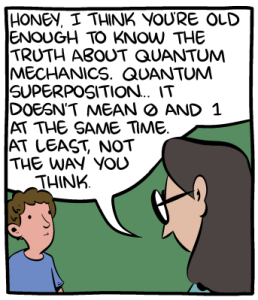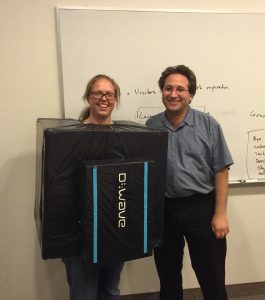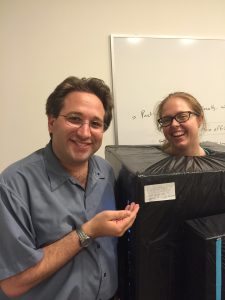In the two months since I last blogged, the US has continued its descent into madness. Yet even while so many certainties have proven ephemeral as the morning dew—the US’s autonomy from Russia, the sanity of our nuclear chain of command, the outcome of our Civil War, the constraints on rulers that supposedly set us apart from the world’s dictator-run hellholes—I’ve learned that certain facts of life remain constant.
The moon still waxes and wanes. Electrons remain bound to their nuclei. P≠NP proofs still fill my inbox. Squirrels still gather acorns. And—of course!—people continue to claim big quantum speedups using D-Wave devices, and those claims still require careful scrutiny.
With that preamble, I hereby offer you eight quantum computing news items.
Cathy McGeoch Episode II: The Selby Comparison
On January 17, a group from D-Wave—including Cathy McGeoch, who now works directly for D-Wave—put out a preprint claiming a factor-of-2500 speedup for the D-Wave machine (the new, 2000-qubit one) compared to the best classical algorithms. Notably, they wrote that the speedup persisted when they compared against simulated annealing, quantum Monte Carlo, and even the so-called Hamze-de Freitas-Selby (HFS) algorithm, which was often the classical victor in previous performance comparisons against the D-Wave machine.
Reading this, I was happy to see how far the discussion has advanced since 2013, when McGeoch and Cong Wang reported a factor-of-3600 speedup for the D-Wave machine, but then it turned out that they’d compared only against classical exact solvers rather than heuristics—a choice for which they were heavily criticized on this blog and elsewhere. (And indeed, that particular speedup disappeared once the classical computer’s shackles were removed.)
So, when people asked me this January about the new speedup claim—the one even against the HFS algorithm—I replied that, even though we’ve by now been around this carousel several times, I felt like the ball was now firmly in the D-Wave skeptics’ court, to reproduce the observed performance classically. And if, after a year or so, no one could, that would be a good time to start taking seriously that a D-Wave speedup might finally be here to stay—and to move on to the next question, of whether this speedup had anything to do with quantum computation, or only with the building of a piece of special-purpose optimization hardware.
A&M: Annealing and Matching
As it happened, it only took one month. On March 2, Salvatore Mandrà, Helmut Katzgraber, and Creighton Thomas put up a response preprint, pointing out that the instances studied by the D-Wave group in their most recent comparison are actually reducible to the minimum-weight perfect matching problem—and for that reason, are solvable in polynomial time on a classical computer. Much of Mandrà et al.’s paper just consists of graphs, wherein they plot the running times of the D-Wave machine and of a classical heuristic on the relevant instances—clearly all different flavors of exponential—and then Edmonds’ matching algorithm from the 1960s, which breaks away from the pack into polynomiality.
But let me bend over backwards to tell you the full story. Last week, I had the privilege of visiting Texas A&M to give a talk. While there, I got to meet Helmut Katzgraber, a condensed-matter physicist who’s one of the world experts on quantum annealing experiments, to talk to him about their new response paper. Helmut was clear in his prediction that, with only small modifications to the instances considered, one could see similar performance by the D-Wave machine while avoiding the reduction to perfect matching. With those future modifications, it’s possible that one really might see a D-Wave speedup that survived serious attempts by skeptics to make it go away.
But Helmut was equally clear in saying that, even in such a case, he sees no evidence at present that the speedup would be asymptotic or quantum-computational in nature. In other words, he thinks the existing data is well explained by the observation that we’re comparing D-Wave against classical algorithms for Ising spin minimization problems on Chimera graphs, and D-Wave has heroically engineered an expensive piece of hardware specifically for Ising spin minimization problems on Chimera graphs and basically nothing else. If so, then the prediction would be that such speedups as can be found are unlikely to extend either to more “practical” optimization problems—which need to be embedded into the Chimera graph with considerable losses—or to better scaling behavior on large instances. (As usual, as long as the comparison is against the best classical algorithms, and as long as we grant the classical algorithm the same non-quantum advantages that the D-Wave machine enjoys, such as classical parallelism—as Rønnow et al advocated.)
Incidentally, my visit to Texas A&M was partly an “apology tour.” When I announced on this blog that I was moving from MIT to UT Austin, I talked about the challenge and excitement of setting up a quantum computing research center in a place that currently had little quantum computing for hundreds of miles around. This thoughtless remark inexcusably left out not only my friends at Louisiana State (like Jon Dowling and Mark Wilde), but even closer to home, Katzgraber and the others at Texas A&M. I felt terrible about this for months. So it gives me special satisfaction to have the opportunity to call out Katzgraber’s new work in this post. In football, UT and A&M were longtime arch-rivals, but when it comes to the appropriate level of skepticism to apply to quantum supremacy claims, the Texas Republic seems remarkably unified.
When 15 MilliKelvin is Toasty
In other D-Wave-related scientific news, on Monday night Tameem Albash, Victor Martin-Mayer, and Itay Hen put out a preprint arguing that, in order for quantum annealing to have any real chance of yielding a speedup over classical optimization methods, the temperature of the annealer should decrease at least like 1/log(n), where n is the instance size, and more likely like 1/nβ (i.e., as an inverse power law).
If this is correct, then cold as the D-Wave machine is, at 0.015 degrees or whatever above absolute zero, it still wouldn’t be cold enough to see a scalable speedup, at least not without quantum fault-tolerance, something that D-Wave has so far eschewed. With no error-correction, any constant temperature that’s above zero would cause dangerous level-crossings up to excited states when the instances get large enough. Only a temperature that actually converged to zero as the problems got larger would suffice.
Over the last few years, I’ve heard many experts make this exact same point in conversation, but this is the first time I’ve seen the argument spelled out in a paper, with explicit calculations (modulo assumptions) of the rate at which the temperature would need to go to zero for uncorrected quantum annealing to be a viable path to a speedup. I lack the expertise to evaluate the calculations myself, but any experts who’d like to share their insight in the comments section are “warmly” (har har) invited.
“Their Current Numbers Are Still To Be Checked”
As some of you will have seen, The Economist now has a sprawling 10-page cover story about quantum computing and other quantum technologies. I had some contact with the author while the story was in the works.
The piece covers a lot of ground and contains many true statements. It could be much worse.
But I take issue with two things.
First, The Economist claims: “What is notable about the effort [to build scalable QCs] now is that the challenges are no longer scientific but have become matters of engineering.” As John Preskill and others pointed out, this is pretty far from true, at least if we interpret the claim in the way most engineers and businesspeople would.
Yes, we know the rules of quantum mechanics, and the theory of quantum fault-tolerance, and a few promising applications; and the basic building blocks of QC have already been demonstrated in several platforms. But if (let’s say) someone were to pony up $100 billion, asking only for a universal quantum computer as soon as possible, I think the rational thing to do would be to spend initially on a frenzy of basic research: should we bet on superconducting qubits, trapped ions, nonabelian anyons, photonics, a combination thereof, or something else? (Even that is far from settled.) Can we invent better error-correcting codes and magic state distillation schemes, in order to push the resource requirements for universal QC down by three or four orders of magnitude? Which decoherence mechanisms will be relevant when we try to do this stuff at scale? And of course, which new quantum algorithms can we discover, and which new cryptographic codes resistant to quantum attack?
The second statement I take issue with is this:
“For years experts questioned whether the [D-Wave] devices were actually exploiting quantum mechanics and whether they worked better than traditional computers. Those questions have since been conclusively answered—yes, and sometimes”
I would instead say that the answers are:
- depends on what you mean by “exploit” (yes, there are quantum tunneling effects, but do they help you solve problems faster?), and
- no, the evidence remains weak to nonexistent that the D-Wave machine solves anything faster than a traditional computer—certainly if, by “traditional computer,” we mean a device that gets all the advantages of the D-Wave machine (e.g., classical parallelism, hardware heroically specialized to the one type of problem we’re testing on), but no quantum effects.
Shortly afterward, when discussing the race to achieve “quantum supremacy” (i.e., a clear quantum computing speedup for some task, not necessarily a useful one), the Economist piece hedges: “D-Wave has hinted it has already [achieved quantum supremacy], but has made similar claims in the past; their current numbers are still to be checked.”
To me, “their current numbers are still to be checked” deserves its place alongside “mistakes were made” among the great understatements of the English language—perhaps a fitting honor for The Economist.
Defeat Device
Some of you might also have seen that D-Wave announced a deal with Volkswagen, to use D-Wave machines for traffic flow. I had some advance warning of this deal, when reporters called asking me to comment on it. At least in the materials I saw, no evidence is discussed that the D-Wave machine actually solves whatever problem VW is interested in faster than it could be solved with a classical computer. Indeed, in a pattern we’ve seen repeatedly for the past decade, the question of such evidence is never even directly confronted or acknowledged.
So I guess I’ll say the same thing here that I said to the journalists. Namely, until there’s a paper or some other technical information, obviously there’s not much I can say about this D-Wave/Volkswagen collaboration. But it would be astonishing if quantum supremacy were to be achieved on an application problem of interest to a carmaker, even as scientists struggle to achieve that milestone on contrived and artificial benchmarks, even as the milestone seems repeatedly to elude D-Wave itself on contrived and artificial benchmarks. In the previous such partnerships—such as that with Lockheed Martin—we can reasonably guess that no convincing evidence for quantum supremacy was found, because if it had been, it would’ve been trumpeted from the rooftops.
Anyway, I confess that I couldn’t resist adding a tiny snark—something about how, if these claims of amazing performance were found not to withstand an examination of the details, it would not be the first time in Volkswagen’s recent history.
Farewell to a Visionary Leader—One Who Was Trash-Talking Critics on Social Media A Decade Before President Trump
This isn’t really news, but since it happened since my last D-Wave post, I figured I should share. Apparently D-Wave’s outspoken and inimitable founder, Geordie Rose, left D-Wave to form a machine-learning startup (see D-Wave’s leadership page, where Rose is absent). I wish Geordie the best with his new venture.
Martinis Visits UT Austin
On Feb. 22, we were privileged to have John Martinis of Google visit UT Austin for a day and give the physics colloquium. Martinis concentrated on the quest to achieve quantum supremacy, in the near future, using sampling problems inspired by theoretical proposals such as BosonSampling and IQP, but tailored to Google’s architecture. He elaborated on Google’s plan to build a 49-qubit device within the next few years: basically, a 7×7 square array of superconducting qubits with controllable nearest-neighbor couplings. To a layperson, 49 qubits might sound unimpressive compared to D-Wave’s 2000—but the point is that these qubits will hopefully maintain coherence times thousands of times longer than the D-Wave qubits, and will also support arbitrary quantum computations (rather than only annealing). Obviously I don’t know whether Google will succeed in its announced plan, but if it does, I’m very optimistic about a convincing quantum supremacy demonstration being possible with this sort of device.
Perhaps most memorably, Martinis unveiled some spectacular data, which showed near-perfect agreement between Google’s earlier 9-qubit quantum computer and the theoretical predictions for a simulation of the Hofstadter butterfly (incidentally invented by Douglas Hofstadter, of Gödel, Escher, Bach fame, when he was still a physics graduate student). My colleague Andrew Potter explained to me that the Hofstadter butterfly can’t be used to show quantum supremacy, because it’s mathematically equivalent to a system of non-interacting fermions, and can therefore be simulated in classical polynomial time. But it’s certainly an impressive calibration test for Google’s device.
2000 Qubits Are Easy, 50 Qubits Are Hard
Just like the Google group, IBM has also publicly set itself the ambitious goal of building a 50-qubit superconducting quantum computer in the near future (i.e., the next few years). Here in Austin, IBM held a quantum computing session at South by Southwest, so I went—my first exposure of any kind to SXSW. There were 10 or 15 people in the audience; the purpose of the presentation was to walk through the use of the IBM Quantum Experience in designing 5-qubit quantum circuits and submitting them first to a simulator and then to IBM’s actual superconducting device. (To the end user, of course, the real machine differs from the simulation only in that with the former, you can see the exact effects of decoherence.) Afterward, I chatted with the presenters, who were extremely friendly and knowledgeable, and relieved (they said) that I found nothing substantial to criticize in their summary of quantum computing.
Hope everyone had a great Pi Day and Ides of March.
 Follow
Follow



